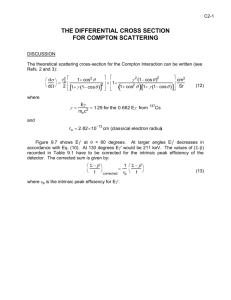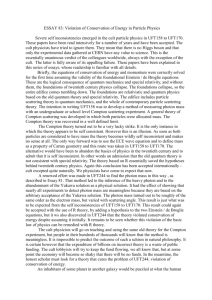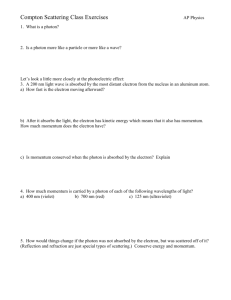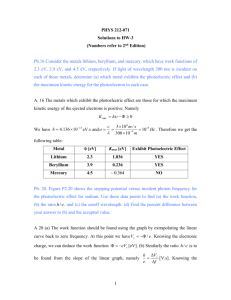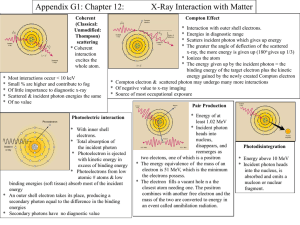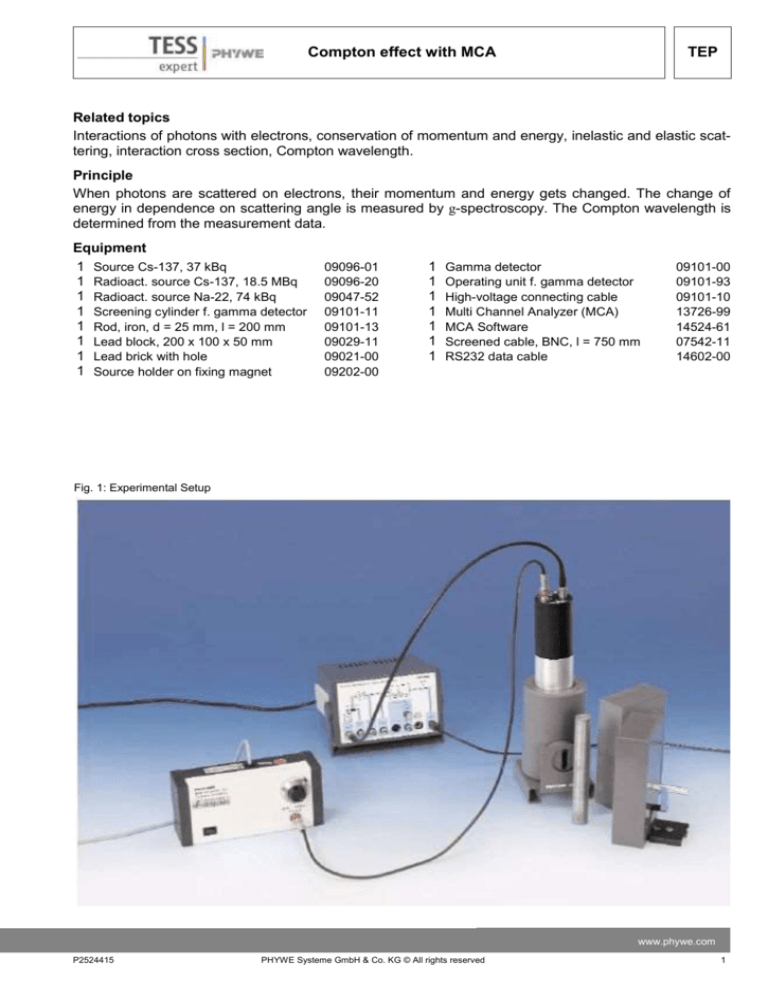
Compton effect with MCA
TEP
Related topics
Interactions of photons with electrons, conservation of momentum and energy, inelastic and elastic scattering, interaction cross section, Compton wavelength.
Principle
When photons are scattered on electrons, their momentum and energy gets changed. The change of
energy in dependence on scattering angle is measured by g-spectroscopy. The Compton wavelength is
determined from the measurement data.
Equipment
1 Source Cs-137, 37 kBq
1 Radioact. source Cs-137, 18.5 MBq
1 Radioact. source Na-22, 74 kBq
1 Screening cylinder f. gamma detector
1 Rod, iron, d = 25 mm, l = 200 mm
1 Lead block, 200 x 100 x 50 mm
1 Lead brick with hole
1 Source holder on fixing magnet
09096-01
09096-20
09047-52
09101-11
09101-13
09029-11
09021-00
09202-00
1
1
1
1
1
1
1
Gamma detector
Operating unit f. gamma detector
High-voltage connecting cable
Multi Channel Analyzer (MCA)
MCA Software
Screened cable, BNC, l = 750 mm
RS232 data cable
09101-00
09101-93
09101-10
13726-99
14524-61
07542-11
14602-00
Fig. 1: Experimental Setup
www.phywe.com
P2524415
PHYWE Systeme GmbH & Co. KG © All rights reserved
1
TEP
Compton effect with MCA
Tasks
Calibrate the set-up with the aid of the 34 kBq 137Cs and the 22Na (74kBq) source.
Measure spectra of the radiation scattered by a steel rod at various angles.
Calculate the Compton wavelength from the spectra.
Set-up and Procedure
Set up the equipment as seen in Fig. 1. Before turning on the operating unit for the scintillation counter,
connect the high voltage cable correctly to operating unit and photomultiplier and read the instructions in
the manual of the gamma-detector. Set the multiturn potentiometer of the operating unit to 2.00. Connect
the multi channel analyzer (MCA) to the computer's USB port or a RS232 serial interface and start the
"measure" program. Select the Gauge "Multi Channel Analyzer".
1. Select "Spectra recording" (see Fig. 2), set the "Gain" to "Level 1", set the "Offset" to 0 %, choose
"Channel number" as x-Data (see Fig. 3) and start data recording. Put the 137Cs pellet into the slot
of the screening cylinder for the g-detector near to the detector. Increase the high voltage with the
multiturn potentiometer until the 662 keV peak gets to about channel 3500. If you are not sure about
the high voltage setting, start with low settings and increase the high voltage, until the 662 keV peak
wanders to the right end of the spectrum. Cancel the measurement and leave the high voltage setting unchanged from now on.
Fig. 2: Start window of the MCA
Now start the MCA gauge again and select "Settings and calibration". The window seen in Fig. 4
appears. Use the "Calibrate" button. Perform the 3-point calibration with the 22Na and the 137Cs
source and use the "Apply" button. Save the calibration as seen on Fig. 5. Remove the 34 kBq
source from the slit of the cylindrical detector screening. Be careful with detector handling – the scintillation crystal breaks easily and cracks in it will reduce sensitivity and energy resolution.
2
PHYWE Systeme GmbH & Co. KG © All rights reserved
P2524415
Compton effect with MCA
TEP
Fig. 3: Window for spectrum recording – here the spectrum
of 137Cs with gain level 1.
Fig. 4: Calibration Window
Fig. 5: Saving the calibration
2. Now return to "Spectra recording" and set the "x-data" to "Energy". Put the 18.5 MBq source into the
lead brick with hole. Adjust the setup in a way that mainly scattered photons from the steel rod get
recorded. The 662 keV line should be well suppressed by the shielding. The presence of the steel
rod should increase the impulse rate distinctly – if you take it away, it should drop clearly. The spectrum should show a distinct maximum from the preferred Compton scattering angle. Record such a
spectrum for each angle (e.g. for 30°, 60°, 90°, 120°) and save the data with the "Accept data" button. Start with high or medium angles.
3. Save the recorded spectra to your disc drive. Different ways may be suitable for finding the maximum of the Compton scattering peak: You may use "Analysis" > "Smooth…" to reduce the statistical
noise in the spectrum and evaluate the peak position with the "Survey" tool. Else you may mark the
interesting region of the spectrum with the "Mark" tool that looks like a cross and then use "Analysis"
> "Function fitting…" to fit a scaled normal distribution with offset to the data (see Fig. 6) and then
use "Analysis" > "Show extrema…" to find the position of the peak of the fit. Plot the Compton scattering peak energy versus the scattering angle. Plot the wavelength λ = hc/E that corresponds to the
www.phywe.com
P2524415
PHYWE Systeme GmbH & Co. KG © All rights reserved
3
TEP
Compton effect with MCA
energy E over the scattering angle and the wavelength shift, too.
Fig. 6: Function fitting
Theory and evaluation
Compton scattering is elastic scattering of photons on electrons. Both momentum and energy conservation are fulfilled and momentum and energy are exchanged between photon and electron the same way
as one would expect of mass points. The energy range is that of the electron's resting mass so the calculation has to be relativistic.
The energy E of a photon depends on it's frequency f and the Planck constant h and is
and the momentum p of a photon with wavenumber k is
If the electron is at rest at the beginning, all the momentum comes from the photon and stays constant
throughout the reaction. After the reaction the initial momentum is split up into the momentum of the photon. The photon moves now under the angle φ to it's initial direction and has the altered frequency f’. The
momentum of the electron after the scattering is pc = mv with the mass as a function of velocity (m ≥me).
The vector sum of both equals the initial momentum and thus holds for the squares of the vectors:
The energy has to be constant throughout the reaction, too and for simplicity counting the electron resting mass equivalent in the equation (the point of zero energy is arbitrary)
with the relativistic relation for electron speed v
4
PHYWE Systeme GmbH & Co. KG © All rights reserved
P2524415
Compton effect with MCA
TEP
which is Compton's formula for the wavelength shift.
Fig. 7: Decay scheme of 137Cs
The wavelength
is called Compton wavelength.
With
is the corresponding energy Ec = mec2 the energy equivalent of the electron's resting mass of 511 keV.
So the energy scale for the Compton effect is set by the electron mass which can be interpreted in the
way that an elastic scattering occurs when the photon is about as "heavy" as the electron.
Fig. 7 shows the decay scheme of the used nuclid 137Cs. The proportions of the energy scale are not
displayed correctly. The main emission is the sharp 662 keV line. But there is a probability of the 11/2exited state of the daugther nuclid 137mBa to decay by inner conversion because of the high difference of
spin quantum number between ground and exited state – in the case of 137mBa leading to a 32 keV X-ray
line and a long half life of the exited state of two and a half minute. Only the photons reach the detector,
electrons cannot leave the source pellet.
Incoming photons of a defined energy are detected in the scintillation counter by the electrons they exite
www.phywe.com
P2524415
PHYWE Systeme GmbH & Co. KG © All rights reserved
5
TEP
Compton effect with MCA
in the scintillator crystal either by photo effect, where they transfer all their momentum and energy to the
electron (photon absorption or completely inelastic scattering), or by Compton scattering, where momentum and energy are exchanged between photon and electron in an elastic scattering. So the measurement result of a sharp photon energy is a whole spectrum consisting of the photo peak and the compton
background. The Compton scattering the photons undergo in the detector is here not of interest – only
the incidents detected by photo effect thus showing the original photon energy should be counted for as
interesting incidents leaving other effects in the spectrum ignored – you are searching for the photo peak
of photons Compton scattered by the steel rod. The set-up is made in a way that only those of the 662
keV photons that have undergone scattering on the steel rod in a defined angle reach the detector and
can be counted and their energy is evaluated in the recorded g-spectrum. The dependence of the energy
E’ of the scattered photons that had reached the steel rod with energy E0 (here 662 keV) on the scattering angle is then from (6):
This function has a maximum for φ = 180°, where no energy is tranferred to the electron and the photon
keeps its initial energy and a minimum for , where the fraction of the initial energy
is reflected.
Fig. 8: Schematic spectrum of Compton electrons
For the spectrum of the electrons exited in the steel rod by Compton effect, though not measured, the
following can be said: In the case of compton scattering there is a highest energy fraction of the initial
energy of the photon that can be transferred to the electron. This energy is transferred, if the photon gets
reflected back into the direction where it came from (back scattering). In the non-relativistic case all scattering angles have equal probability so all the other electron energies are of equal probability if not filtered for angle, too – i.e. the spectrum of the electron energies is flat from zero up to a maximum energy,
where it drops to zero. To each electron energy corresponds a defined scattering angle. In the relativistic
case backscattering is preferred compared to other angles and the electron spectrum shows a rise to the
maximum energy (see Fig. 4) – the precise form predicted by the Klein-Nishina formula.
6
PHYWE Systeme GmbH & Co. KG © All rights reserved
P2524415


